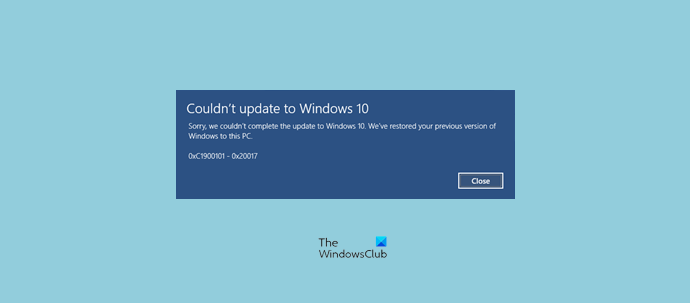The error codes could be any of these – 0xC1900101-0x20004, 0xC1900101-0x2000c, 0xC1900101-0x20017, 0xC1900101-0x30018, 0xC1900101-0x3000D, 0xC1900101-0x4000D or 0xC1900101-0x40017.
Windows Update error 0xC1900101
This error is usually caused due to a device driver issue. If you face this issue, here are a few things you could try. You may need administrator permissions on your device to be able to execute some of these tasks.
1] Make sure that your device has enough space
It’s one of the most common problems faced by Windows users when updating their system. You will need to have a minimum of 16 GB of free space to upgrade a 32-bit OS or 20 GB for a 64-bit OS. This space should be available in your C drive as Windows downloads the updates in that folder. In case you cannot manage to get space in that drive, you can either try to free up drive space using Disk Cleanup Tool or move the Windows update download folder to some other drive or external storage.
2] Run Windows Update a few times
Sometimes Windows Updates don’t work right off the bat. You need to try it a couple of times – it could help at times.
3] Run Windows Update Troubleshooter
You should run the inbuilt Windows Update Troubleshooter and see if that helps you.
4] Run Microsoft’s online troubleshooter
You can also fix Windows Update Errors using Microsoft’s online troubleshooter. Maybe this will help.
5] Unplug extra or additional hardware
If updating drivers does not help, you can remove all extra hardware, i.e., those which are externally plugged in including external hard disk, gaming accessories and so on. Sometimes Windows tries figuring out the drivers for them as well and gets stuck.
6] Update third-party drivers
It is always a good idea to update all your drivers for the third-party accessories you have installed on your Windows. It can be your network driver or graphics driver. If you can’t find an update through Windows, check with the OEM website, and update it.
7] Check Device Manager for errors
The Device Manager (Win+X+M) is the best place to check if any of your connected hardware has any issue. They are usually marked with a yellow exclamation mark under their defined category. Once you open the Device Manager, expand each hardware category and look for any issue. You can then choose to update the drivers or disable them and see if the update completes.
8] Disable third-party security software
Anit-Virus and Security solutions are known to be notorious when it comes to making any high-level changes in the Windows Update. You can try either disabling such software, including Windows Defender or completely uninstall them till you fix the Update issues
9] Repair hard-drive errors
A hard drive can have issues which can make Windows Update fail as the system thinks the system is not healthy. You should run chkdsk in the command prompt to resolve those issues. Running the following command would be a good idea.
10] Restore and repair Windows Update files
DISM is the tool you need to run from the command prompt. It will not only fix common errors but can also repair corrupted Windows Update files.
11] Perform a Clean Boot to install Windows Updates
Boot into Clean Boot State and run Windows Updates and see. It is very likely that this could work. This will help you stay connected with the internet, download and install the updates with minimum conflict issue. Related read: Installation failed in SAFE_OS phase with an error during BOOT operation, 0xC1900101 – 0x20017. Let us know if this guide helped you solve the issue.

